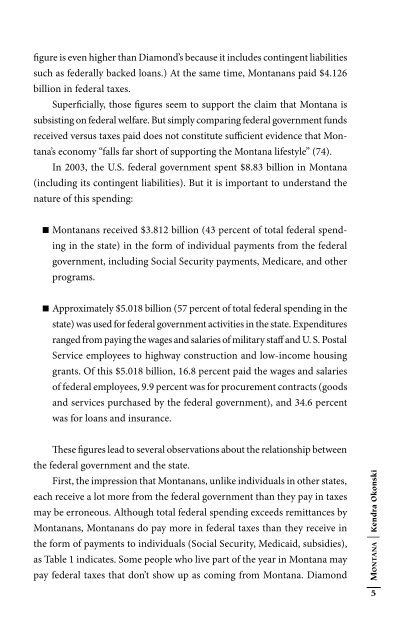Montana: On the Verge of Collapse - PERC
Montana: On the Verge of Collapse - PERC
Montana: On the Verge of Collapse - PERC
Create successful ePaper yourself
Turn your PDF publications into a flip-book with our unique Google optimized e-Paper software.
figure is even higher than Diamond’s because it includes contingent liabilities<br />
such as federally backed loans.) At <strong>the</strong> same time, <strong>Montana</strong>ns paid $4.126<br />
billion in federal taxes.<br />
Superficially, those figures seem to support <strong>the</strong> claim that <strong>Montana</strong> is<br />
subsisting on federal welfare. But simply comparing federal government funds<br />
received versus taxes paid does not constitute sufficient evidence that Mon-<br />
tana’s economy “falls far short <strong>of</strong> supporting <strong>the</strong> <strong>Montana</strong> lifestyle” (74).<br />
In 2003, <strong>the</strong> U.S. federal government spent $8.83 billion in <strong>Montana</strong><br />
(including its contingent liabilities). But it is important to understand <strong>the</strong><br />
nature <strong>of</strong> this spending:<br />
<strong>Montana</strong>ns received $3.812 billion (43 percent <strong>of</strong> total federal spend-<br />
ing in <strong>the</strong> state) in <strong>the</strong> form <strong>of</strong> individual payments from <strong>the</strong> federal<br />
government, including Social Security payments, Medicare, and o<strong>the</strong>r<br />
programs.<br />
Approximately $5.018 billion (57 percent <strong>of</strong> total federal spending in <strong>the</strong><br />
state) was used for federal government activities in <strong>the</strong> state. Expenditures<br />
ranged from paying <strong>the</strong> wages and salaries <strong>of</strong> military staff and U. S. Postal<br />
Service employees to highway construction and low-income housing<br />
grants. Of this $5.018 billion, 16.8 percent paid <strong>the</strong> wages and salaries<br />
<strong>of</strong> federal employees, 9.9 percent was for procurement contracts (goods<br />
and services purchased by <strong>the</strong> federal government), and 34.6 percent<br />
was for loans and insurance.<br />
These figures lead to several observations about <strong>the</strong> relationship between<br />
<strong>the</strong> federal government and <strong>the</strong> state.<br />
First, <strong>the</strong> impression that <strong>Montana</strong>ns, unlike individuals in o<strong>the</strong>r states,<br />
each receive a lot more from <strong>the</strong> federal government than <strong>the</strong>y pay in taxes<br />
may be erroneous. Although total federal spending exceeds remittances by<br />
<strong>Montana</strong>ns, <strong>Montana</strong>ns do pay more in federal taxes than <strong>the</strong>y receive in<br />
<strong>the</strong> form <strong>of</strong> payments to individuals (Social Security, Medicaid, subsidies),<br />
as Table 1 indicates. Some people who live part <strong>of</strong> <strong>the</strong> year in <strong>Montana</strong> may<br />
pay federal taxes that don’t show up as coming from <strong>Montana</strong>. Diamond<br />
MONTANA | Kendra Okonski<br />
5




